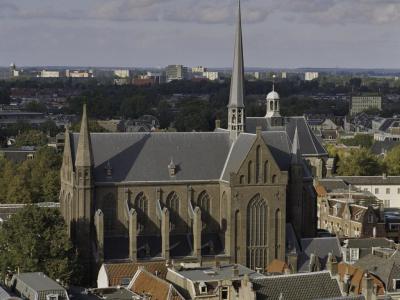Sint-Willibrordkerk (St. Willibrord's Church), Utrecht
Saint Willibrord's Church in Utrecht is a striking example of Dutch Gothic Revival architecture and a hidden treasure within the city’s historic center. Located on Minrebroeder Street, near the renowned Dom Church, it has been a designated National Monument since 1976. The church is currently operated by the traditionalist Society of Saint Pius X and owned by the Saint Willibrordus Foundation.
Constructed between 1875 and 1877, the church was designed by the prominent architect Alfred Tepe, showcasing the Utrecht School of Gothic Revival. Its unassuming, sober exterior belies the stunningly elaborate and colorful interior, which was extensively decorated by artists of the Saint Bernulphus Guild. Nearly every surface is adorned with vibrant paintings, intricate wood carvings, and stained glass windows depicting the life of Saint Willibrord. A particular highlight is the set of tabernacle doors painted by Jacob Ydema in 1939. The church also houses a renowned organ built by Maarschalkerweerd.
The church’s choir is the most extensively decorated area, with a strong focus on the symbolism of the Holy Sacrament. Due to its location surrounded by city buildings, the structure was designed to be tall yet compact, with high windows allowing natural light to enhance its interior beauty. The interior was not fully completed until 1891, fourteen years after its dedication by Monsignor Schaepman in 1877.
In the 1960s, the Diocese of Utrecht planned to sell and demolish the church, but a group of laypeople, led by Father Winand Kotte, stepped in to preserve it. Their efforts ensured that the church remained intact, and in 2005, a large-scale restoration was completed to maintain its vibrant and ornate decor.
Today, Saint Willibrord’s Church continues to serve its religious function while also being a cultural venue. To support its upkeep, the church is frequently used for classical concerts during the week, allowing visitors to experience its remarkable acoustics and breathtaking artistry in a unique setting.
Constructed between 1875 and 1877, the church was designed by the prominent architect Alfred Tepe, showcasing the Utrecht School of Gothic Revival. Its unassuming, sober exterior belies the stunningly elaborate and colorful interior, which was extensively decorated by artists of the Saint Bernulphus Guild. Nearly every surface is adorned with vibrant paintings, intricate wood carvings, and stained glass windows depicting the life of Saint Willibrord. A particular highlight is the set of tabernacle doors painted by Jacob Ydema in 1939. The church also houses a renowned organ built by Maarschalkerweerd.
The church’s choir is the most extensively decorated area, with a strong focus on the symbolism of the Holy Sacrament. Due to its location surrounded by city buildings, the structure was designed to be tall yet compact, with high windows allowing natural light to enhance its interior beauty. The interior was not fully completed until 1891, fourteen years after its dedication by Monsignor Schaepman in 1877.
In the 1960s, the Diocese of Utrecht planned to sell and demolish the church, but a group of laypeople, led by Father Winand Kotte, stepped in to preserve it. Their efforts ensured that the church remained intact, and in 2005, a large-scale restoration was completed to maintain its vibrant and ornate decor.
Today, Saint Willibrord’s Church continues to serve its religious function while also being a cultural venue. To support its upkeep, the church is frequently used for classical concerts during the week, allowing visitors to experience its remarkable acoustics and breathtaking artistry in a unique setting.
Want to visit this sight? Check out these Self-Guided Walking Tours in Utrecht. Alternatively, you can download the mobile app "GPSmyCity: Walks in 1K+ Cities" from Apple App Store or Google Play Store. The app turns your mobile device to a personal tour guide and it works offline, so no data plan is needed when traveling abroad.
Sint-Willibrordkerk (St. Willibrord's Church) on Map
Sight Name: Sint-Willibrordkerk (St. Willibrord's Church)
Sight Location: Utrecht, Netherlands (See walking tours in Utrecht)
Sight Type: Religious
Guide(s) Containing This Sight:
Sight Location: Utrecht, Netherlands (See walking tours in Utrecht)
Sight Type: Religious
Guide(s) Containing This Sight:
Walking Tours in Utrecht, Netherlands
Create Your Own Walk in Utrecht
Creating your own self-guided walk in Utrecht is easy and fun. Choose the city attractions that you want to see and a walk route map will be created just for you. You can even set your hotel as the start point of the walk.
Utrecht Introduction Walking Tour
The earliest settlers to the area now called Utrecht likely arrived millennia ago during the Stone Age. While there are also signs of inhabitation during the Bronze Age, scholars today credit the Romans with building what became the town.
They set up a castellum around the year 50 AD, a fort right at a crossing point on the river Rhine. The fortress marked Rome's northernmost point in... view more
Tour Duration: 1 Hour(s)
Travel Distance: 1.6 Km or 1 Miles
They set up a castellum around the year 50 AD, a fort right at a crossing point on the river Rhine. The fortress marked Rome's northernmost point in... view more
Tour Duration: 1 Hour(s)
Travel Distance: 1.6 Km or 1 Miles
Utrecht's Historical Buildings Walking Tour
Originally founded by the Romans, and once the most important city in the Netherlands, Utrecht boasts a generous share of historically significant structures. The collection of its architectural masterpieces, one of the richest in the country, dates back to the early Middle Ages.
The amazingly well-preserved pieces of historic architecture in Utrecht showcase the trends and movements throughout... view more
Tour Duration: 2 Hour(s)
Travel Distance: 3.8 Km or 2.4 Miles
The amazingly well-preserved pieces of historic architecture in Utrecht showcase the trends and movements throughout... view more
Tour Duration: 2 Hour(s)
Travel Distance: 3.8 Km or 2.4 Miles





